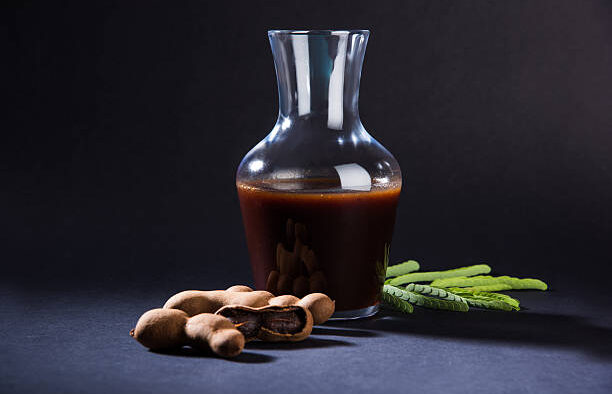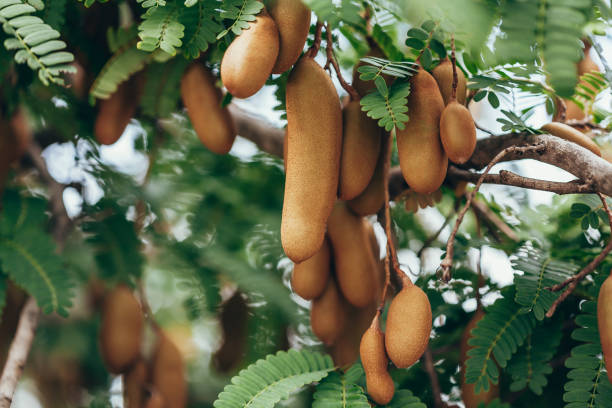Amlika-phala-pānaka is made from ripe tamarind (Tamarindus indica) fruit, which hang from its leguminous tree as brown bean-like pods filled with seeds surrounded by a fibrous pulp
To cool the body from the inside, especially during hot summers, Ayurveda advised us to take the bounty of nature in the season and understand its gifts. Simple combinations of fruits, spices and clean water were used to create refreshing sweet cooling drinks that actually changed the heat production in the body, in effect making people feel cooler.
Pitta is the dosha of metabolism and radiating heat. While it is responsible for the functions of enzymes and hormones, it also creates a latent heat that is desired in winter but abhored in intense heated environments. Remedies are pitta-shamaka (shamaka, reducing, resolving, S.), and are usually fresh, cooling, and sweet. The fresh and sweet neutralizes the heat of acids produced in hot micro-environments.
Many pānakas are described in the pākaśāstra, texts of Ayurveda devoted to the topics of dietetics, culinary arts and the science and art of cooking (paka, S., to cook). Pānaka (पानक, S., syrup) are light sweet thick liquid drinks made with citric acid, sugar and digestive spices. The citric acid base comes from items as tamarind, lemon, green mango, coriander, and buttermilk. The combination transforms the heating properties into a net cooling effect if made properly.
Tamarind
Ripe tamarind fruits, known as imli or amlika in Sanskrit, appear throughout the tropics in late March, as the heat increases.
Amlika-phala-pānaka is made from ripe tamarind (Tamarindus indica) fruit, which hang from its leguminous tree as brown bean-like pods filled with seeds surrounded by a fibrous pulp. The ancient physician Bhava Misra shared many cooling recipes from his native southwestern Bengal, in the 15th century classic Ayurvedic text known as Bhava Prakasha. In his chapter on stews and food combinations (kṛtanna), he shares several pānaka recipes that take ingredients from various geo-climatic zones and seasons in which one might find the particular ingredients needed to create these hima. Hima are a medicine form in which specific drugs are combined together for a particular effect using cool water.
The recipe for amlika-phala-pānaka uses the fresh pulp of tamarind fruits, which give tartaric acid, clean fresh water, red cane rock sugar, lavanga, and black pepper to create a light, watery, sweet-and-sour syrup that awakens the taste buds.
The medicinal benefits of amlika-phala-pāṇaka are its ability to create a healthy hunger or appetite, which normally wanes in the heat of summer. The sweet-sour tangy taste reduces vata doshas in the body, but it should not be used in excess because it also mildly increases pitta and kapha. Clove, which is the flower bud of the clove tree, known as lavanga, provides a good smell and can alter the food experience with its flavor. Lavaṅga/clove is also known for its role as a deepana drug in Ayurveda, increasing digestive fire. It is ruchikara, increasing the flow of taste at the level of the tongue, and also improves the appetite for food. It is an effective agent in the treatment of asthma (shwasa) and cough (kasa-roga) as well. The well-known black peppercorn provides a property of shroto-sodhana, opening and cleaning blocked channels in the body.

*********************************
अम्लिकाफलपानक
अम्लिकायाः फलं पक्वं मर्दितं वारिणा दृढम् |
शर्करामरिचैर्मिश्रं लवङ्गेन्दुसुवासितम् ||१३२||
अम्लिकाफलसम्भूतं पानकं वातनाशनम् |
पित्तश्लेष्मकरं किञ्चित्सुरुच्यं वह्निबोधनम् ||१३३||
Bhava Prakasha Nighantu, kṛtanna varga, chapter 12, slokas 132-133
Transliteration: amlikāphalapānaka
amlikāyāḥ phalaṁ pakvaṁ marditaṁ vāriṇā dr̥ḍham |
śarkarāmaricairmiśraṁ lavaṅgēndusuvāsitam ||132||
amlikāphalasambhūtaṁ pānakaṁ vātanāśanam |
pittaślēṣmakaraṁ kiñcitsurucyaṁ vahnibōdhanam ||133||
Translation: Fresh ripe tamarind fruits, which look like long pods with brown thick sticky pulp, is removed from shell and seed. It is then mashed with proper quantity of water to make it a paste; then, crushed sugar, fresh powder of black pepper, and fresh-ground clove powder should be added with it. This preparation is amlika phala pana. It notably is a good preparation for reducing vata (vata-nasaka), but it also causes increase in pitta and kapha also. This drink increases the sensation in the taste buds (ruchi-karaka) and enhances the body's main digestive fire.
*********************************
Ingredients
Fresh ripe tamarind - 4 fruits
Fresh clean water - 2 litre
Red cane sugar - 50 g (about 10 tsp)
Lavanga/cloves, fresh ground - 2 g
Black pepper, fresh ground - 3 g
Recipe

From a local tamarind tree, freshly pick 4 large ripe tamarinds. Wash them with clean water to remove the hard covers, any dust or grime. Put the whole tamarind in an earthen pot. Add 2 liters of clean, fresh water and mash the four pods in the vessels using the water to melt the contents from the pod. After properly mashing and removing the skin and central seeds, mix the pulp and water until it is smooth. Hand-grind 10 teaspoons red cane sugar in a stone mortar-pestle until it is ground to powder, then add it to the tamarind water. Add freshly-ground clove/lavanga and freshly-ground black pepper (golmorich, kali mirch, marica, Piper nigrum). Stir well for five minutes, adding prayers for good health. Serve with a smile. The rims of the serving glasses may be lined with ground red cane sugar.







